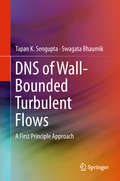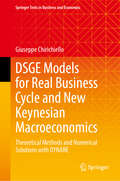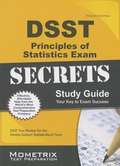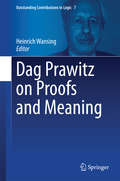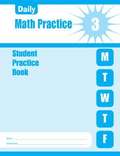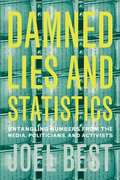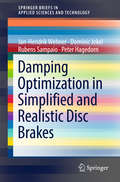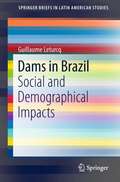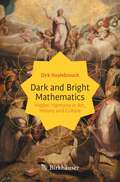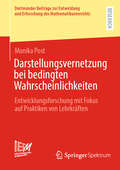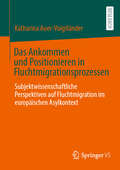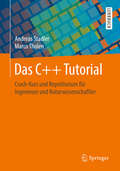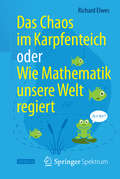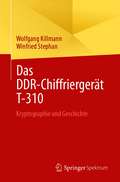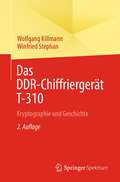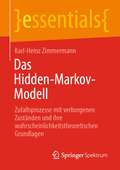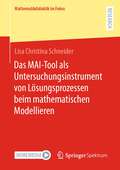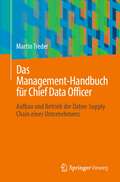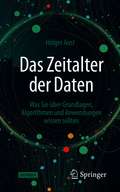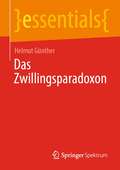- Table View
- List View
DNS of Wall-Bounded Turbulent Flows: A First Principle Approach
by Tapan K. Sengupta Swagata BhaumikThis book highlights by careful documentation of developments what led to tracking the growth of deterministic disturbances inside the shear layer from receptivity to fully developed turbulent flow stages. Associated theoretical and numerical developments are addressed from basic level so that an uninitiated reader can also follow the materials which lead to the solution of a long-standing problem. Solving Navier-Stokes equation by direct numerical simulation (DNS) from the first principle has been considered as one of the most challenging problems of understanding what causes transition to turbulence. Therefore, this book is a very useful addition to advanced CFD and advanced fluid mechanics courses.
DSGE Models for Real Business Cycle and New Keynesian Macroeconomics: Theoretical Methods and Numerical Solutions with DYNARE (Springer Texts in Business and Economics)
by Giuseppe ChirichielloThis textbook introduces graduate and upper undergraduate students to Dynamic Stochastic General Equilibrium (DSGE) models. As DSGE models become integral in advanced coursework, this book serves as an invaluable guide, explaining the complexities with a methodological red thread across its five chapters. Starting with the stochastic dynamic models of the Real Business Cycle (RBC) and progressing through the field of New Keynesian Macroeconomics (NKE), it employs DSGE models to shed light on the dynamic nature of economic systems.The book presents the Blanchard-Kahn methodology for theoretical solutions, discussing its usefulness and limitations as models evolve in complexity. The book goes on to explain the shift from analytical to numerical solutions, showcasing the DYNARE software and providing coding insights. Unique to this volume is a chapter on difference equations, equipping students with essential mathematical tools, and a concluding exploration of a medium-sized NewKeynesian Economics model.This book will equip students to navigate the theoretical complexities of the topic and to independently replicate and comprehend the presented results. It bridges the gap between classical and Keynesian paradigms, reviving the debate in today's "RBC vs NKE" landscape. It will enable students to master the essence of macroeconomic theories and methodologies, paving the way for their scholarly pursuits.
DSST Principles of Statistics Exam Secrets Study Guide
by Dsst Exam Secrets Test Prep StaffDSST Principles of Statistics Exam Secrets helps you ace the Dantes Subject Standardized Tests, without weeks and months of endless studying. Our comprehensive DSST Principles of Statistics Exam Secrets study guide is written by our exam experts, who painstakingly researched every topic and concept that you need to know to ace your test. Our original research reveals specific weaknesses that you can exploit to increase your exam score more than you've ever imagined.
Dag Prawitz on Proofs and Meaning (Outstanding Contributions to Logic #7)
by Heinrich WansingThis volume is dedicated to Prof. Dag Prawitz and his outstanding contributions to philosophical and mathematical logic. Prawitz's eminent contributions to structural proof theory, or general proof theory, as he calls it, and inference-based meaning theories have been extremely influential in the development of modern proof theory and anti-realistic semantics. In particular, Prawitz is the main author on natural deduction in addition to Gerhard Gentzen, who defined natural deduction in his PhD thesis published in 1934. The book opens with an introductory paper that surveys Prawitz's numerous contributions to proof theory and proof-theoretic semantics and puts his work into a somewhat broader perspective, both historically and systematically. Chapters include either in-depth studies of certain aspects of Dag Prawitz's work or address open research problems that are concerned with core issues in structural proof theory and range from philosophical essays to papers of a mathematical nature. Investigations into the necessity of thought and the theory of grounds and computational justifications as well as an examination of Prawitz's conception of the validity of inferences in the light of three "dogmas of proof-theoretic semantics" are included. More formal papers deal with the constructive behaviour of fragments of classical logic and fragments of the modal logic S4 among other topics. In addition, there are chapters about inversion principles, normalization of p roofs, and the notion of proof-theoretic harmony and other areas of a more mathematical persuasion. Dag Prawitz also writes a chapter in which he explains his current views on the epistemic dimension of proofs and addresses the question why some inferences succeed in conferring evidence on their conclusions when applied to premises for which one already possesses evidence.
Daily Math Practice Student Edition (Grade #3)
by Evan-Moor Educational Publishers StaffGive your students their own math practice book, ideal for daily warm-up, review, or homework. The student book corresponds to the teachers edition and courseware with math practice specifically developed to meet Common Core.
Daily Math Thinking Routines in Action: Distributed Practices Across the Year
by Nicki NewtonBring math to life with routines that are academically rigorous, standards-based, and engaging! Go beyond circling ABCD on your bell ringers and do nows and get your students reasoning, modeling, and communicating about math every day! In this new book from bestselling author and consultant Dr. Nicki Newton, you’ll learn how to develop effective daily routines to improve students’ thinking, reasoning, and questioning about math. The book provides a wide variety of rigorous, high-interest routines and explains how to rotate and implement them into your curriculum. Inside, you’ll find: Questioning techniques that encourage students to think beyond the "right vs. wrong" continuum Tips for building a math-learning environment that is friendly and supportive of all students Math vocabulary exercises that are meaningful and fun An assortment of innovative daily activities, including "Fraction of the Day," "Truth or Fib," "Find and Fix the Error," "Guess My Number," "What Doesn’t Belong?" and many, many more. Each chapter offers examples, charts, and tools that you can use immediately. With these resources and the practical advice throughout the book, you’ll increase students’ ability to understand math on a deeper level while keeping them engaged in their own learning processes.
Damned Lies and Statistics: Untangling Numbers from the Media, Politicians and Activists
by Joel BestWhile startling statistics shape the thinking about social issues, the author attests that these numbers can be wrong. This book is a lively guide to spotting bad statistics and learning to think critically about these influential numbers.
Damping Optimization in Simplified and Realistic Disc Brakes (SpringerBriefs in Applied Sciences and Technology)
by Rubens Sampaio Jan-Hendrik Wehner Dominic Jekel Peter HagedornThe main goal of this book is to show how to modify and optimize the properties of the damping matrix in order to find the most beneficial way of adding damping to a given mechanical system. To this end, a two-degree-of-freedom model of disc brake is analyzed to gain insight into the fundamental physical behavior of damping. In addition, more realistic, high-dimensional finite element brake models are studied and optimized for stability.
Dams in Brazil: Social and Demographical Impacts (SpringerBriefs in Latin American Studies)
by Guillaume LeturcqThe book focuses on the human and social effects of the construction of hydroelectric dams in Brazil. It discusses themes such as forced migrations, how the families of the victims of the dams adapt to new living areas, the struggle of families with the relocation of their homes and the fact that they are neglected by builders and government. These discussions are carried out in a comparative perspective between Southern and Northern Brazil, where contexts and living conditions are quite different. The book's main objective is to analyze the movements, adaptations and life changes in families suffering from the effects of dams throughout Brazil. This is the first book that analyzes the relationship dam-space with the intent to understand how dams affect the territory. The book is organized in three chapters: the dams’ effects in Brazil and the territorial impacts; human and social consequences of dam construction; a regional comparison of the effects of dams between the South and the North of the country.
Daniele Barbaro and the University of Padova: Architecture, Art and Science on the Occasion of the 450th Anniversary of His Death (Trends in the History of Science)
by Kim Williams Cosimo MonteleoneThis book, edited by Kim Williams and Cosimo Monteleone, follows the publication of two other books dedicated to Daniele Barbaro and published by Springer: Daniele Barbaro's Vitruvius of 1567 (Kim Williams, 2019) and Daniele Barbaro's Perspective of 1568 (Kim Williams and Cosimo Monteleone, 2021). Therefore, it can be considered another installment in a series that has deepened the scientific treatises published by Daniele Barbaro. Due to the numerous scientific interests that Barbaro matured in the years he spent at the University of Padua, we have invited experts in these topics to discuss Barbaro in relation to his training. In particular, the book opens with the essays of the two editors to frame its general theme in relation to mathematics. Cosimo Monteleone addressed the relationship between Barbaro's perspective theory with Euclid's optics, the Aristotelian process of knowledge and the ophthalmological discoveries of the University of Padova in the Renaissance. Kim Williams underlines how Barbaro's arithmetic and geometry established `the most certain sciences' and set the base of the `primary sciences'. A series of essays concerning Barbaro's training at the University of Padua complete the theoretical framework analyzed by the two editors. These studies embrace the following subjects: mathematical instruments (Filippo Camerota), astronomy and sundials (Cristiano Guarneri), mathematics, geometry and polyhedral (Vera Viana), perspective and anamorphosis (Agostino De Rosa), botany and the foundation of the botanical garden (Stefano Zaggia), Vitruvius' architecture (Ekaterina Igoshina, Ilya Anikyev, Anna Markova) and Aristotelianism (Branko Mitrović). A foreword by Xavier Salomon sets the stage for this book, outlining the innovations that Barbaro brought to scientific knowledge.Barbaro's scientific efforts are sometimes dismissed in recent studies as a compilation of known principles. The aim of this present book is to reveal the truly innovative nature of Barbaro's experiments and results and restore him to his rightful place as an original scholar of Renaissance.
Dark and Bright Mathematics: Hidden Harmony in Art, History and Culture (Copernicus Books)
by Dirk HuylebrouckWas it necessary for a 17th century painter to know principles of optics to hide a skull in one of his masterpieces? Is it possible the violent deaths of Roman emperors obey a statistical law? Are there connections between market trends and geometry? How did Islamic artists draw almost perfectly regular nine-sided polygons, when these cannot be traced with the use of compasses? Dirk Huylebrouk asks these and other exciting questions in this collection of essays, originally written for the science magazine EOS, a Dutch equivalent of Scientific American, distributed in Belgium and in The Netherlands. Every chapter can be read independently, as some subjects are repeated, and not strictly interconnected. Such is the case for instance of the golden section, an often-recurring topic in general mathematics. The reader will appreciate the original point of view expressed through each chapter, which makes this book stand out against the general information one can find by browsing the general media. The subtly provocative character of some parts is meant to stimulate the reader for further exploration. The book's title itself may already generate surprise. Sure, to many, mathematics seems to come from hell, but the darkness in the title in fact refers to the lugubrious stories about math and skulls, murders or World War II. There is also a more down-to-earth part is about math and maps, money, Facebook, folding paper, shapes in ice and the most earthly yet unsolved math problems. ‘Bright mathematics’ alludes to Vedic, Islam, New Age, a meta-divine section, and is concluded by an interview with a top mathematician who also wrote about the existence of God.
Darstellungsvernetzung bei bedingten Wahrscheinlichkeiten: Entwicklungsforschung mit Fokus auf Praktiken von Lehrkräften (Dortmunder Beiträge zur Entwicklung und Erforschung des Mathematikunterrichts #55)
by Monika PostBedingte Wahrscheinlichkeiten stellen sowohl Jugendliche als auch Erwachsene vor Herausforderungen, unter anderem beim Verständnis des Konzepts und beim Dekodieren von Aussagen zu Wahrscheinlichkeiten. In diesem Buch entwickelt und untersucht die Autorin Monika Post in einer Entwicklungsforschungsstudie verstehens- und sprachförderliche Unterrichtsansätze zur Förderung konzeptuellen Verständnisses zu bedingten Wahrscheinlichkeiten und nutzt hierzu das Designprinzip der Darstellungsvernetzung. Durch Verschränkung der semiotischen und epistemischen Perspektive betrachtet sie das Designprinzip der Darstellungsvernetzung im Zusammenhang mit relevanten Verstehenselementen zu bedingten Wahrscheinlichkeiten in seinen Wirkungen und Gelingensbedingungen. Aufgrund der Relevanz des Handelns von Lehrkräften für Lerngelegenheiten wird der Fokus über die Untersuchung von Lernprozessen hinaus auf Lehrprozesse gesetzt. Neben gemeinsamen Lernwegen einer Klassengemeinschaft rekonstruiert und untersucht die Autorin daher unterrichtliche Praktiken von Lehrkräften zur Etablierung von Darstellungsverknüpfung.
Das Alter - Impulse für die bessere Hälfte
by Wolfgang BlohmVorurteile und Mythen des Alters hinterfragt: Der Autor Dr. Wolfgang Blohm lädt Sie ein, die Lebensphase des Altwerdens neu zu entdecken. Was erleben Sie bei der Lektüre? Statt Warten auf den Tod, Depression und Inkontinenz finden sich neue Bewertungen, Denkimpulse und immer auch ein Augenzwinkern. Wer am Älterwerden verzweifelt oder jedes graue Haar einzeln zählt, sollte “Das Alter – Impulse für die bessere Hälfte“ mit Neugierde lesen. Daneben empfiehlt sich die Lektüre für alle, die schon einmal einen Blick über den Zaun der Zukunft werfen möchten. Denn alt werden möchte fast jeder. Dieses Buch öffnet den Blick für viele neue Perspektiven auf die wichtigen lebensnahen Bereiche. Veränderungen lassen sich gestalten, Freiräume im Leben, im Lieben und im Wohnen sehr bekömmlich nutzen. Auch vermeintliche Tabus wie Sexualität, Verjüngungsmedizin oder das Lebensende können dabei ihre Scheu verlieren. Mehr als dreißig Jahre ärztliche und psychotherapeutische Erfahrung in der Praxis, in der eigenen Klinik und als mehrfacher Buchautor bringt Dr. med. Blohm neben seinem Lebensalter in dieses Buch mit ein
Das Ankommen und Positionieren in Fluchtmigrationsprozessen: Subjektwissenschaftliche Perspektiven auf Fluchtmigration im europäischen Asylkontext
by Katharina Auer-VoigtländerDie vorliegende Studie untersucht Ankommensprozesse und Subjektpositionierungen im Kontext von Fluchtmigrationsbewegungen. Dabei interessiert sich die Forschung dafür, wie sich diese Prozesse gestalten und welche Bedeutung sie für die betreffenden Subjekte haben. Die Grounded Theory Studie fokussiert auf eine spezifische Phase der Fluchtmigrationsprozesse – nämlich das Ankommen in einem neuen soziokulturellen Kontext – und betrachtet dies aus einer subjektwissenschaftlichen Perspektive. Aufbauend auf den Ergebnissen von vier Fallanalysen werden im Rahmen einer kontrastiven Analyse entlang von verschiedenen Vergleichskategorien – darunter Handlungsorientierungen, Sozialkapitalbeziehungen, Kollektiv- und Individualpositionierungen, Umgang mit Subjektpositionen sowie Wahrnehmungen und Deutungen von Ankommensprozessen – Typen von Handlungs- und Bewältigungsstrategien im Kontext des Ankommens fluchtmigrierter Menschen im diskursiven Raum des europäischen Asylkontextes erarbeitet.
Das C++ Tutorial: Crash-kurs Und Repetitorium Für Ingenieure Und Naturwissenschaftler
by Andreas Stadler Marco TholenDieses Tutorial hilft nicht nur Ingenieuren und Naturwissenschaftlern beim schnellen Einstieg und der Vertiefung in die Programmierung mit C++. Kommentierte Aufgaben, lebensnahe Beispiele und eine kompakte sowie systematische Struktur zeichnen dieses Buch aus.
Das Chaos im Karpfenteich oder Wie Mathematik unsere Welt regiert
by Richard ElwesVon gespiegelten Universen, sozialen Netzwerken, dem Aufstieg des Homo oeconomicus und dem Ärger im Lehrerzimmer Kann uns die Mathematik helfen, besser zu lügen? Wird es Maschinen geben, die klüger sind als wir? Wie wäre es, in einem gespiegelten Universum zu leben? Was können wir von Fischen in einem Teich lernen? Ob Sie es glauben oder nicht - Antworten auf all diese Fragen finden Sie in der Welt der Zahlen. Mathematik ist einfach überall. Dieses Buch behandelt in 35 kurzen Kapiteln ihre überraschendsten Anwendungen im Alltag. Es holt das oft so ungeliebte Fach aus dem Klassenzimmer mitten ins Leben, und es zeigt, wie die Mathematik jenes ,,verborgene Netz" knüpft, das unsere Welt durchdringt und beherrscht. Richard Elwes lädt sie zu einer anregenden Entdeckungsreise ein. Es geht um Wettervorhersagen, Wahlen und Warteschlangen, um bildgebende Verfahren und schwarze Löcher, um ein mathematisches Modell, wie man zu Reichtum gelangt, und um Einsteins Wegweiser durch den Raum. Sie werden die Formel für jedes jemals geschossene Foto kennenlernen und sich Ihrer eigenen Erbsubstanz nähern. Das Chaos im Karpfenteich zeigt, warum die oft so fremd erscheinende Welt der Mathematik Ihnen viel näher und vertrauter ist, als Sie es sich bisher vorstellen konnten.
Das DDR-Chiffriergerät T-310: Kryptographie und Geschichte
by Wolfgang Killmann Winfried StephanDieses Buch beschreibt, unter welchen Bedingungen das in der DDR am weitesten verbreitete Fernschreibchiffriergerät sowie der dazugehörige Algorithmus vor etwa 50 Jahren zum Schutz von Staatsgeheimnissen entwickelt wurden. Der Leser kann die damaligen Methoden und Ergebnisse mit den aktuellen Möglichkeiten einer kryptologischen Analyse vergleichen – insbesondere unter dem Aspekt der heute zur Verfügung stehenden Computertechnik. Es wird herausgearbeitet, dass die konsequente Anwendung von Methoden der Gruppen- und Automatentheorie in der Analyse eine zentrale Rolle spielte. Dieser algebraische Analyseansatz aus der sowjetischen Schule wird bis heute unterschätzt – die Betrachtungsweisen können auch für Nichtkryptologen unter den Lesern von Nutzen sein. Darüber hinaus werden die Unterschiede dargestellt zwischen der Analyse des Chiffrieralgorithmus, der Sicherheitsanalyse des Geräts und der Chiffrierverfahren, in denen es zum Einsatz kommt. Schließlich wird auch das Ende der T-310 beschrieben, das mit dem Untergang der DDR einhergeht: Das Gerät wurde letztmalig im Vereinigungsprozess auf einer gesicherten Fernschreibverbindung zwischen Bonn und Berlin eingesetzt.Beide Autoren sind studierte Mathematiker und wirkten maßgeblich an der Entwicklung und Analyse der T-310 mit. Hier berichten erstmals Insider über diese Arbeit.
Das DDR-Chiffriergerät T-310: Kryptographie und Geschichte
by Wolfgang Killmann Winfried StephanDieses Buch beschreibt, unter welchen Bedingungen das in der DDR am weitesten verbreitete Fernschreibchiffriergerät sowie der dazugehörige Algorithmus vor etwa 50 Jahren zum Schutz von Staatsgeheimnissen entwickelt wurden. So können die damaligen Methoden und Ergebnisse mit den aktuellen Möglichkeiten der kryptologischen Analyse verglichen werden – insbesondere unter dem Aspekt der heute zur Verfügung stehenden Computertechnik.Es wird herausgearbeitet, dass die konsequente Anwendung von Methoden der Gruppen- und Automatentheorie in der Analyse eine zentrale Rolle spielte. Dieser algebraische Analyseansatz aus der sowjetischen Schule wird bis heute unterschätzt – die Betrachtungsweisen können auch für Nichtkryptologen von Nutzen sein. Darüber hinaus werden die Unterschiede dargestellt zwischen der Analyse des Chiffrieralgorithmus, der Sicherheitsanalyse des Geräts und der Chiffrierverfahren, in denen es zum Einsatz kommt.Die Ergänzungen in der zweiten Auflage beruhen auf Informationen früherer Mitarbeiter und auf Dokumenten aus den 80er Jahren, die erst nach Erscheinen der Erstauflage zugänglich wurden: Auf der Basis von Originaldokumenten wird nun die Historie der T-310-Entwicklung ausgehend vom Vorläuferalgorithmus SKS genauer dargestellt. Außerdem gelang es den Autoren, einige zuvor nicht lösbare Probleme mit der heute zur Verfügung stehenden Computertechnik zu bearbeiten – daran wird deutlich, wie begrenzt die Rechenkapazität in den 70er und 80er Jahren war. Schließlich wird der letzte Einsatz der T-310 zur Realisierung von gesicherten Fernschreibverbindungen zwischen Ministerien der BRD und der DDR rekonstruiert.
Das Eigene und das Fremde: Eine Untersuchung zum Fremdverstehen von Lehrkräften im Mathematikunterricht
by Claudia-Susanne GüntherIm Mathematikunterricht stehen Lehrkräfte tagtäglich vor der Aufgabe, das Verhalten ihrer Schülerinnen und Schüler zu verstehen. Sie sehen, was die Lernenden tun, und hören, was sie sagen. Und sie fragen sich dann: Was erleben die Lernenden, wenn sie tun, was sie tun, und sagen, was sie sagen? Die vorliegende Arbeit rückt diesen Prozess des Fremdverstehens von Lehrkräften im Mathematikunterricht ins Zentrum des Forschungsinteresses und setzt sich zum Ziel, ihn empirisch zu rekonstruieren und theoretisch zu beschreiben. Auf diese Weise trägt sie zu einem tieferen Verständnis eines Prozesses bei, der sich in jeder sozialen Situation zwischen Mathematiklehrenden und -lernenden vollzieht.
Das Hidden-Markov-Modell: Zufallsprozesse mit verborgenen Zuständen und ihre wahrscheinlichkeitstheoretischen Grundlagen (essentials)
by Karl-Heinz ZimmermannIm Mittelpunkt dieses essentials steht eine Einführung in ein bekanntes statistisches Modell, das Hidden-Markov-Modell.Damit können Probleme bewältigt werden, bei denen aus einer Folge von Beobachtungen auf die wahrscheinlichste zustandsspezifische Beschreibung geschlossen werden soll.Die Anwendungen des Hidden-Markov-Modells liegen hauptsächlich in den Bereichen Bioinformatik, Computerlinguistik, maschinelles Lernen und Signalverarbeitung.In diesem Büchlein werden die beiden zentralen Problemstellungen in HMMs behandelt.Das Problem der Inferenz wird mit dem berühmten Viterbi-Algorithmus gelöst, und das Problem der Parameterschätzung wird mit zwei bekannten Methoden angegangen (Erwartungsmaximierung und Baum-Welch).
Das MAI-Tool als Untersuchungsinstrument von Lösungsprozessen beim mathematischen Modellieren (Mathematikdidaktik im Fokus)
by Lisa Christina SchneiderLisa Schneider entwickelt und implementiert ein Untersuchungsinstrument zur Analyse von Lösungsprozessen beim mathematischen Modellieren, das Modelling-Activity-Interaction-Tool (MAI-Tool). Das MAI-Tool zeichnet sich durch eine digitale Erfassung sowie eine automatisierte Darstellung und algorithmische Auswertung der Daten aus. Im Rahmen einer empirischen Studie wird das MAI-Tool angewendet, in der Modellierungsprozesse von Lernenden beim Lösen einer mathematischen Modellierungsaufgabe untersucht werden: Die Hälfte der Lernenden erhielt eine Unterweisung in idealtypische Modellierungsprozesse, die andere Hälfte nicht. Der Einfluss der Unterweisung auf die Struktur individueller Lösungsprozesse kann nachgewiesen werden und daraus ableitend Hürden während des Modellierens identifiziert werden. Außerdem werden Ergebnisse hinsichtlich des Zusammenhangs von Interaktionen und der Gruppenstruktur präsentiert. Die in der Studie erhobenen Daten werden zur Entwicklung eines Algorithmus mit Machine Learning verwendet, der individuelle Lösungsprozesse anhand von Strukturmerkmalen klassifiziert. Insgesamt leistet diese Forschungsarbeit einen Beitrag zur Grundlagenforschung in mathematischer Modellierung auf technologischer, empirischer und algorithmischer Ebene.
Das Management-Handbuch für Chief Data Officer: Aufbau und Betrieb der Daten-Supply Chain eines Unternehmens
by Martin TrederEs lässt sich nicht leugnen, dass das 21. Jahrhundert datengesteuert ist, wobei viele digitale Branchen auf die sorgfältige Erfassung und Analyse großer Mengen von Informationen angewiesen sind. Ein Chief Data Officer (CDO) in einem Unternehmen ist der Leiter dieses Prozesses, was diese Position oft zu einer Herausforderung macht. Das Chief Data Officer Management Handbook soll hier Abhilfe schaffen.In diesem Buch gibt der Autor Martin Treder Ratschläge, wie CDOs besser auf ihren Verantwortungsbereich vorbereitet werden können, wie sie einen nachhaltigeren Ansatz entwickeln und wie sie die typischen Fallstricke vermeiden können. Basierend auf den positiven und negativen Erfahrungen aktueller CDOs hilft das Chief Data Officer Management Handbook dabei, die ideale Struktur eines Datenbüros zu entwerfen, sie zu implementieren und die richtigen Leute an Bord zu holen.Wichtige Themen wie die Datenversorgungskette, die Datenstrategie und die Data Governance werden von Treder sorgfältig behandelt. Als CDO ist es wichtig, dass Sie Ihre Position mit Ihrem gesamten Team effektiv nutzen. Das Chief Data Officer Management Handbook ermöglicht es allen Mitarbeitern, die Verantwortung für die Zusammenarbeit im Bereich Daten zu übernehmen. Daten sind die Grundlage heutiger und zukünftiger technologischer Innovationen, und Sie könnten die Führungspersönlichkeit sein, die die nächste große Veränderung bewirkt.Was Sie lernen werden:Wichtige Elemente eines effektiven Datenmanagements anwendenSie erhalten einen umfassenden Überblick über alle Datenbereiche (die oft unabhängig voneinander verwaltet werden) Arbeiten Sie mit der Datenversorgungskette, von der Datenerfassung bis zur Datennutzung, einer Überprüfung aller relevanten Interessengruppen, der Datenstrategie und der DatenverwaltungFür wen ist dieses Buch gedacht?CDOs, Datenverantwortliche, Datenberater und alle Fachleute, die verstehen wollen, wie ein Datenbüro in einer Organisation funktioniert.
Das RSA-Verfahren: Klartext für Nichtmathematiker (essentials)
by Guido WalzDieses kompakte essential vermittelt die mathematischen Grundlagen des RSA-Verfahrens. Es stellt dafür – bewusst beispielorientiert statt beweisvollständig – zunächst die algebraischen Grundlagen sowie den (erweiterten) euklidischen Algorithmus und schließlich natürlich das RSA-Verfahren selbst dar. Außerdem wird eine kurze Einordnung des Verfahrens in die Welt der Kryptographie gegeben und seine Risiken dargestellt.
Das Zeitalter der Daten: Was Sie über Grundlagen, Algorithmen und Anwendungen wissen sollten
by Holger AustDaten werden überall gesammelt. Jeder Kauf, ob online oder offline, jede Autofahrt und jede Benutzung des Smartphones erzeugt Daten, die gespeichert werden. So entstehen Datenberge, die in atemberaubendem Tempo wachsen – für 2020 geht man von 40 Billionen Gigabytes aus. Aber was passiert dann mit diesen Daten? Wie werden sie ausgewertet? Und wer macht das? Holger Aust nimmt Sie mit auf einen unterhaltsamen Ausflug in die wunderbare Welt der Data Science. Sein Buch richtet sich an alle, die schon immer wissen wollten, wie Maschinen anhand von Daten lernen und ob sie dadurch (künstliche) Intelligenz erlangen. Sie erfahren natürlich auch, was neuronale Netze und Deep Learning eigentlich mit all dem zu tun haben. In leicht verständlichem Stil erhalten Sie außerdem Einblicke in die Funktionsweise der wichtigsten Algorithmen und lernen konkrete Beispiele, Herausforderungen und Risiken aus der Praxis kennen: Sie erfahren etwa, wie Mobilfunkanbieter ihre Kunden bei Laune halten, wie Erdbebenvorhersage funktioniert und warum auch Computer zum Schubladendenken neigen.
Das Zwillingsparadoxon (essentials)
by Helmut GüntherDie bewegte Uhr geht nach. – Zwei Zwillinge bewegen sich in entgegengesetzter Richtung. Beide beobachten, dass die Uhr des anderen nachgeht. Dann kommen sie wieder zusammen und stellen fest: Jünger ist, wer seine Geschwindigkeit geändert hat. Eine elementare Erklärung dafür folgt aus einer Kette von Ungleichungen auf der Basis der Zeitdilatation. Mit Hilfe der Definition einer absoluten Gleichzeitigkeit finden wir eine weitere, einfache Erklärung. Hierbei ist es wichtig, den definitorischen Charakter der Gleichzeitigkeit zu verstehen. Alternativ zu Einsteins Herleitung formulieren wir einen anschaulichen Zugang zur Speziellen Relativitätstheorie. Dabei können wir über die Gleichzeitigkeit frei verfügen und lösen das Paradoxon sowohl mit der Lorentz-Transformation als auch bei absoluter Gleichzeitigkeit.
